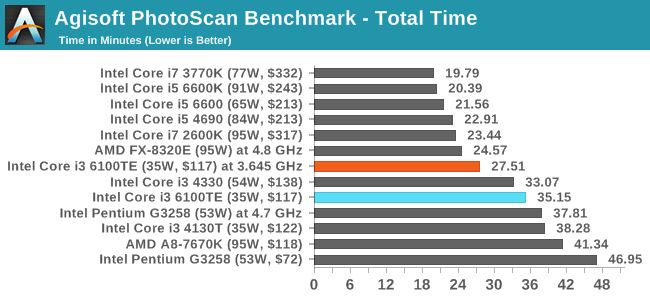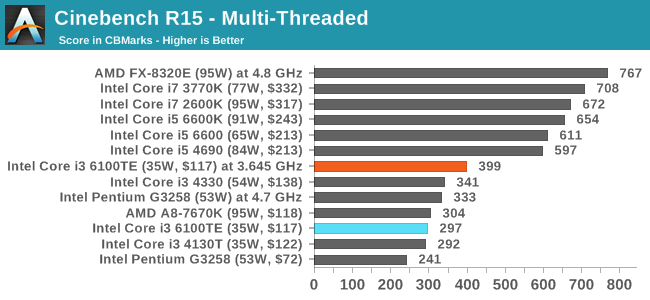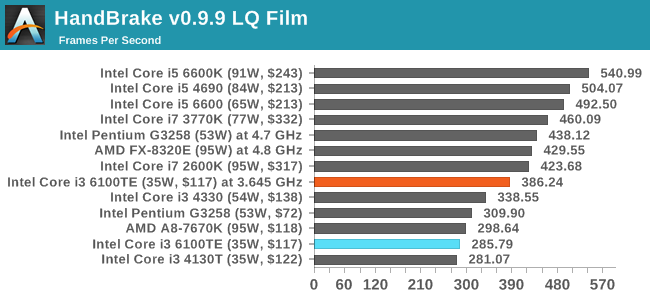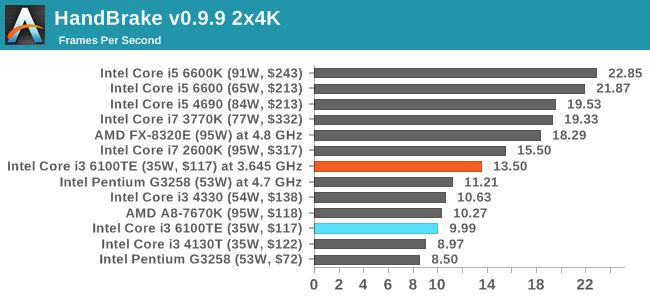Why an Overclockable Core i3 Might Not Exist: The Supermicro C7H170-M and Intel Core i3-6100TE Review
by Ian Cutress on March 17, 2016 10:30 AM EST- Posted in
- CPUs
- Intel
- Motherboards
- Core i3
- Supermicro
- Overclocking
Professional Performance: Windows
Agisoft Photoscan – 2D to 3D Image Manipulation: link
Agisoft Photoscan creates 3D models from 2D images, a process which is very computationally expensive. The algorithm is split into four distinct phases, and different phases of the model reconstruction require either fast memory, fast IPC, more cores, or even OpenCL compute devices to hand. Agisoft supplied us with a special version of the software to script the process, where we take 50 images of a stately home and convert it into a medium quality model. This benchmark typically takes around 15-20 minutes on a high end PC on the CPU alone, with GPUs reducing the time.

The variable workload of Agisoft means there are parts where the code path is single threaded and others where multithreading is near perfect. As a result we see the overclocked i3 march past almost all the AMD parts but not up to the Core i5s.
Cinebench R15
Cinebench is a benchmark based around Cinema 4D, and is fairly well known among enthusiasts for stressing the CPU for a provided workload. Results are given as a score, where higher is better.


HandBrake v0.9.9: link
For HandBrake, we take two videos (a 2h20 640x266 DVD rip and a 10min double UHD 3840x4320 animation short) and convert them to x264 format in an MP4 container. Results are given in terms of the frames per second processed, and HandBrake uses as many threads as possible.


At double 4K, Handbrake requires enough cache and buffers to keep supplying frames. The Core i3 line has a reduced L3 compared to the Core i5s, but also has to share it between threads (1.5MB/thread compared to 2MB per core) which can cause bottlenecks.










62 Comments
View All Comments
Taristin - Thursday, March 17, 2016 - link
Total War: Atilla shows the incorrect graph for performance with a GTX card. It shows the Alien Isolation score (Which is... significantly different!)yannigr2 - Thursday, March 17, 2016 - link
Did I saw an Athlon 845 somewhere in there? Is a review incoming?Bad Bimr - Thursday, March 17, 2016 - link
I miss the days of the cheap CPU with BIG TIME OC potential. My first foray in OCing was with the legendary Celeron 300A. That got me hooked. Next was the P3 600 and next came the P4 2.8 (Northwood) followed by the i7-920. Last year I bought a i7-4790k only to sell it when I came upon a thread on X-58 Xeon overclocking. Currently rocking a very conservative Xeon x5675 @ 4.15 Ghz (25x166) on stock voltage on air on all 6 cores with HT on. I have had it stable to 4.4 GHz but feel better with the lower voltage, plenty fast enough. Total cost for the x5675, $76 on eBay! I love cheap CPU overclocking.OrphanageExplosion - Friday, March 18, 2016 - link
This is a remarkable article. Anandtech has overclocked a *really slow* Core i3 processor so that it's not as fast as the slowest consumer-level i3 and written a *15-page* piece on it?!Why didn't you just buy the Core i3 6100?
The data elsewhere demonstrates why Intel never released a K i3 - it gives quad-like performance for gaming at 4.4GHz, where the i5 is king. The value argument is diluted a bit by the fact you will need a third party cooler though, while the i5 6500 is pretty awesome just with a stock HSF and some fast DDR4.
I really, really hope that AMD targets this sector aggressively with Zen - it could be a game-changer.
ReverendDC - Friday, March 18, 2016 - link
The perfect explanation why AMD is needed in the CPU space as well. No competition = restrictions to force more purchases from a single vendor.Achaios - Friday, March 18, 2016 - link
I was thinking, looking at the gaming benchmarks, that I am going to be stuck with the 4770k for maaaaaaannnnyyyy years to come.JoeyJoJo123 - Friday, March 18, 2016 - link
I honestly think asking why an i3 K-series processor doesn't exist is an awful question.I think the real question here that everyone isn't asking is:
"Why is Intel even selling non-K processors in anything but business grade (Xeon) CPUs?"
Doing a 15 page investigation where you compare an awful starting point locked i3 sample (one that isn't even relevant to consumers), examining its overclocked results, and the results of a locked i5 sample, then concluding that yes, the lower grade processor indeed does have worse performance than an i5, that might be why they don't have a K-series i3, is both completely obvious yet misses the point entirely.
Overclocking is a choice for the consumer. Whether or not the i3 part fully closes the gap with an i5 part is irrelevant, and if it doesn't close the gap, that's not a valid reason to then conclude that's why they don't sell K-series i3's. Overclocking gets me more performance than stock, and regardless of how big or small the overclock is, it should be up to the user to choose whether to overclock, not up to the manufacturer to dictate whether you can attempt to overclock at all (with non-K chips.)
I still can't understand why people are trying to find logic in strategic marketing placement of Intel chips (ie: rationalizing it for Intel, exactly what their marketing department wants) when you should be asking "Why are you selling me a locked down chip? I should be free to run this at whatever level of performance I can muster, as after I purchase this product, it is wholly mine to use as I please"
RobATiOyP - Sunday, March 20, 2016 - link
From the OEM & Intel's point of view, having ppl add volts & frequency to their complicated processors, may well lead to unstable chips or non-functioning, which may be (attempted) to be returned under warranty. If you buy a 3GHz locked CPU they're not fleecing you by not letting it be run faster, like options you pay more for.What is more annoying to me, is how there are various instruction options, like encryption & virtualisation which they turn on/off for market segmentation.
zodiacfml - Friday, March 18, 2016 - link
Awesome. More care and effort was given here than I expected.Simply, Intel refuses to. Limiting higher frequencies to i5 and i7. The market Intel is limiting is gaming market. They might open it if AMD, miraculously, becomes competitive again.
TheHolyLancer - Friday, March 18, 2016 - link
honestly i think the author missed the fact that intel( and amd to a point ) prices their stuff no-linearlyto jump from a pentium to i3 may only be 50 but to jump from i5 to i7k or the extreme (well soon? for the 2011 revamp?) costs a lot more
i remember the i7 920 too and with an oc i had i7 965 extreme levels of performance for way way cheaper